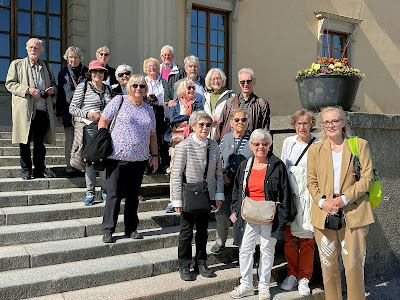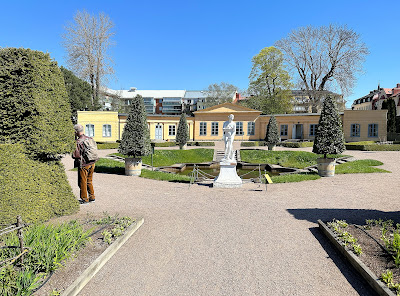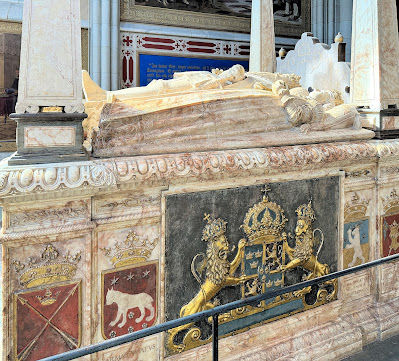Red Baron is getting older, so I vowed to stop flying four years ago and limit
myself to rail travel in Europe.
Then came Corona and later
the official trip of the city of Freiburg to our sister city in the US,
Madison. So I decided to book
my very last flight to Chicago, followed by the onward journey to Madison. Then it was to be the end of
flying.
In early 2023, Professor
Rudolf Denk
told me about a cultural trip to Sweden with literature and landscape. We are
both members of Freiburg's
Museumsgesellschaft, and since bookings were slow at the beginning, he asked me to promote this
trip on our website.
Long story short. Many members of the Museumsgesellschaft, including
myself, signed up, and I may add right away that it was a very successful trip
that took us to Stockholm, Uppsala, Falun, Mårbacka, Karstad, Karlskoga,
Mariefred, and back to Stockholm from May 12 to 18.
My gentle readers may remember a
Museumsreise, i.e., a three-day
trip with the
Museumsgesellschaft to central Switzerland. The highlight
at that time was an
open-air performance of William Tell, which impressed Elisabeth and me. Rudolf and his charming
wife Christel had organized a fantastic trip then.

|
Will Swiss LX 1250 Zürich-Stockholm be my last flight?
The
sparkling wine is from Geneva, where I spent 32 years of my professional
life.
|
This time, too, we were not disappointed. Together with our "Scandinavian-phone"
tour guide Tina, Rudolf, and Christal pulled off a program that led from one
highlight to the next. The encounters we had, the information we got, and the
photos we took were so dense and numerous that one blog is not enough to
describe everything. Therefore, Red Baron will write a blog for each full day
in Sweden, so the complete report will result in a pentalogy.
Uppsala, Cult site of the Vikings and of Knowledge

|
|
On our way to the cathedral: A house of 1666
|
After a first night in Uppsala, in the morning, we visited the Gothic
St. Eric's Cathedral, which is the highest church building in Scandinavia at 118.7
meters.

|
| The interior |
In the center of the choir is a 1583 funerary monument to King
Gustav I Wasa. He liberated the Swedish territory from the ruling Danes in 1520. The Swedish
Riksdag elected Gustav Wasa hereditary king in 1523. Below the monument, he and his three not-at-the-same-time wives are buried in a crypt.

|
Mark 16:
And when the Sabbath was past, Mary Magdalene and Mary,
the
mother of James and Salome, got spices so that they might come
and
put them on him. And very early after dawn on the first day of
the week,
they arrived at the time of the coming up of the sun to
the place
where the body had been put. And they were
saying among themselves,
Who will get the stone rolled
away from the door for us? And looking up,
they saw that
the stone was rolled back; and was of great size.
They saw
a young man[sitting on the right side]
clothed in a long white
garment, and they were affrighted.
|
The visit to the University Library
Carolina Redivida was the day's
highlight because we were allowed to see the
Codex Argenteus, also
called the Wulfila Bible.

|
|
The Codex's itinerary
|

|
|
The Lord's Prayer in Gothic
|

|
| A group photo |

|
The Viking is everywhere.
|

|
|
Looking back to St. Eric's. |

|
|
Crossing Uppsala's river the Fyrisån
|

|
|
Carl Linnaeus smoking the Dutch pipe seen at the
Carolina Redivida
|

|
One of Linnaeus' mottos from his Philosophia Botanica:
Everything is miraculous, even the commonplace.
|

|
|
At the Linnaeus Museum
|

|
|
A look at the Orangery with a copy of the Medici Venus.
|

|
|
Linnaeus on the sexuality of plants
|

|
Well deserved: A brygg kaffe and a pekannöt paj
(A
brewed coffee and a pecan nut pie) at the Café Linné
|

|
| Café Linné |
Falun, Home of the Swedish Red
Before we gained our Falun hotel, we visited the Stora Kopparberg church
and its graveyard.
Gravestone in the churchyard of Stora Kopparbergs kyrka: "In memory of miner
Mats Israelsson, killed at work in the Falun mine, 1677." What makes this
grave so particular?
The disappearance of miner Fet Mats
Israelsson in the Falun mine in 1677, just before his wedding, and the
finding of his corps in 1719 became a historical and literary event. His
bride could identify the body almost entirely preserved
in copper vitriol.
Among others,
Johann Peter Hebel
described the
Faithful Love, "Gray and shriveled up, an old lady comes on a crutch, recognizes her
bridegroom and sinks down more with joyful rapture than with pain on the
beloved corpse."

|
| View of Falun's ski jumps from my hotel window. |
*




















































